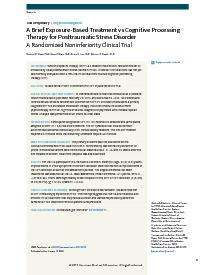A Brief Exposure-Based Treatment vs Cognitive Processing Therapy for Posttraumatic Stress Disorder : A Randomized Noninferiority Clinical Trial
IMPORTANCE Written exposure therapy (WET), a 5-session intervention, has been shown to efficaciously treat posttraumatic stress disorder (PTSD). However, this treatment has not yet
been directly compared with a first-line PTSD treatment such as cognitive processing therapy (CPT).
OBJECTIVE To determine if WET is noninferior to CPT in patients with PTSD.
DESIGN, SETTING, AND PARTICIPANTS In this randomized clinical trial conducted at a Veterans Affairs medical facility between February 28, 2013, and November 6, 2016, 126 veteran and nonveteran adults were randomized to either WET or CPT. Inclusion criteria were a primary diagnosis of PTSD and stable medication therapy. Exclusion criteria included current psychotherapy for PTSD, high risk of suicide, diagnosis of psychosis, and unstable bipolar illness. Analysis was performed on an intent-to-treat basis.
INTERVENTIONS Participants assigned to CPT (n = 63) received 12 sessions and participants assigned to WET (n = 63) received 5 sessions. The CPT protocol that includes written accounts was delivered individually in 60-minute weekly sessions. The first WET session requires 60 minutes while the remaining 4 sessions require 40 minutes.
MAIN OUTCOMES AND MEASURES The primary outcomewas the total score on the Clinician-Administered PTSD Scale for DSM-5; noninferiority was defined by a score of 10 points. Blinded evaluations were conducted at baseline and 6, 12, 24, and 36 weeks after the first treatment session. Treatment dropout was also examined.
RESULTS For the 126 participants (66 men and 60 women; mean [SD] age, 43.9 [14.6] years), improvements in PTSD symptoms in the WET condition were noninferior to improvements in the CPT condition at each of the assessment periods. The largest difference between treatments was observed at the 24-week assessment (mean difference, 4.31 points; 95%CI, –1.37 to 9.99). There were significantly fewer dropouts in the WET vs CPT condition (4 [6.4%] vs 25 [39.7%]; 2 1 = 12.84, Cramer V = 0.40).
CONCLUSIONS AND RELEVANCE Although WET involves fewer sessions, it was noninferior to CPT in reducing symptoms of PTSD. The findings suggest that WET is an efficacious and efficient PTSD treatment that may reduce attrition and transcend previously observed barriers to PTSD treatment for both patients and providers.
Geachte bezoeker,
De informatie die u nu opvraagt, kan door psychotraumanet niet aan u worden getoond. Dit kan verschillende redenen hebben,
waarvan (bescherming van het) auteursrecht de meeste voorkomende is. Wanneer het mogelijk is om u door te verwijzen naar de bron
van deze informatie, dan ziet u hier onder een link naar die plek.
Als er geen link staat, kunt u contact opnemen met de bibliotheek,
die u verder op weg kan helpen.
Met vriendelijke groet,
Het psychotraumanet-team.
In: JAMA Psychiatry, ISSN 2168-622X ; eISSN 2168-6238 | 75 | 3 | 233-239
http://doi.org/10.1001/jamapsychiatry.2017.4249


